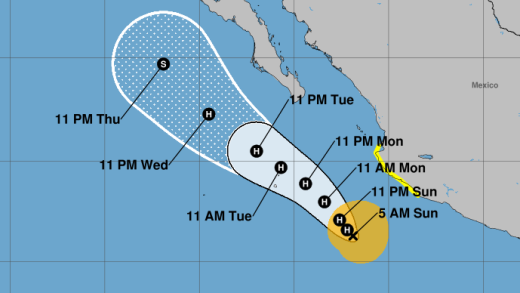Paul Brown,
Kayleen Devlin,
Erwan Rivault and
Barbara MetzlerBBC Verify
 Getty Images
Getty ImagesAs thousands of Gazans made the journey back to their neighbourhoods following the ceasefire, many of them already knew their homes were in ruins.
The prospect of rebuilding homes, businesses and all the institutions and services needed for a return to normal life in Gaza is daunting by any measure: the UN estimates that the damage amounts to $70bn.
As Prof Andreas Krieg, a Middle East security expert from King’s College London, says: “It’s worse than starting from scratch – here you aren’t starting in the sand, you are starting with rubble.”
The level of destruction on the strip is “now in the region of 84%. In certain parts of Gaza, like in Gaza City, it’s even up to 92%”, says Jaco Cilliers, UN Development Programme special representative for the Palestinians.
This damage has created colossal amounts of rubble. Assessments by BBC Verify based on recent satellite data suggest there could be over 60 million tonnes of debris waiting to be cleared in Gaza.
Any process of post-conflict reconstruction must begin by clearing the remnants of war.
Clearing the rubble
The many millions of tonnes of rubble now littering the Gaza Strip are not just piles of concrete and twisted metal. They also contain human remains and unexploded bombs.
“From a safety and humane perspective, the first thing you have to do is make the sites that have been bombed-out safe,” says former JCB executive Philip Bouverat.
There follows a process of sorting, separation and crushing the debris. After materials like plastic and steel are removed, the remaining concrete can be ground up and reused.
This will lay the foundations of construction, but building efforts will require the mass import of materials.
“This isn’t going to be done by trucks coming across the border. The first thing we need to do is build a deep-water port, because then you can bring thousands of container-loads in”, Mr Bouverat added.
When the sites are cleared, then essential services such as water, sewerage and electricity can be restored, he says.
Water and sewerage
Clean water is a major immediate need for Gazans. According to estimates from Unicef, more than 70% of the territory’s 600 water and sanitation facilities have been damaged or destroyed since 7 October 2023.
After the recent announcement of a ceasefire, Israeli soldiers posed in front of a wastewater treatment plant in Gaza City that had been set on fire. The damage came just before Israel’s military withdrew from a position near this infrastructure.
Wastewater treatment is critical for preventing the build-up of sewage and the spread of disease. Doctors have said Gaza has high rates of diarrhoeal diseases, which can kill children, and a risk of cholera in some areas.
In satellite imagery, you can see damage to the bio-towers of the Sheikh Ejleen wastewater treatment plant, which are the main components used for treating sewage.
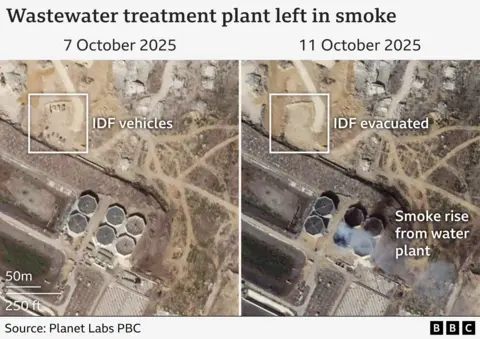
There are six wastewater treatment plants in Gaza. “All of them are damaged,” said Maher Najjar, deputy director at Coastal Municipalities Water Utility (CMWU) which oversees and manages repairs for Gaza’s water infrastructure.
Since the beginning of the war, repairs have been hugely hampered by the immediate danger from Israeli air and artillery attacks and a shortage of tools, he said. Some facilities have been attacked again after being repaired.
The IDF said its actions are “based on military necessity and with accordance to international law”, as it tries to prevent Hamas “threatening the citizens of Israel”.
Alongside facilities that treat sewage, Gaza has separate plants that provide clean drinking water and which have also experienced major damage.
Satellite images from April 2024 show a seawater desalination plant which supplied northern Gaza and Gaza City still intact. But by early May, it had been destroyed.
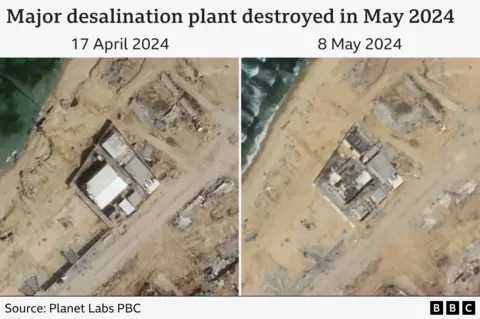
“We are talking about damaged water wells, damaged networks, reservoirs, carrier lines. It’s very hard to know where to start. To begin with we need at least $50m to return around 20% of the services to the population,” Mr Najjar said.
“The total loss is around $1bn, maybe more.”
Housing
Satellite images show the devastation in an area of Sheikh Radwan, a neighbourhood in the north-east of Gaza City.
In August before the IDF occupied the city, which it called the “last stronghold” of Hamas, many streets appeared largely intact. By last week, whole swathes of the neighbourhood had been flattened as the IDF established a base.
Over the course of the war, the UN’s satellite centre Unosat estimates a total of 282,904 houses and apartments across Gaza have been damaged or destroyed.
But these figures are likely to be an underestimate, because they do not yet include the recent military operations in Gaza City, such as the destruction in Sheikh Radwan.
The chart below shows how the rate of housing damage increased sharply in the middle of 2024 – coinciding with IDF operations in Rafah, which left much of the city in ruins. Another significant spike is likely to have occurred as a result of the Gaza City occupation.
Gaza City’s Hamas-run Municipality has said that 90% of its roads have also been damaged.
According to Shelly Culbertson, a senior policy researcher at the Washington-based think tank, RAND Corporation, the rebuilding of Gaza’s housing “could take decades.”
“After the Israeli bombing of Gaza in 2014 and 2021 reconstruction of housing was slow because Israel wouldn’t allow in a lot of construction materials because they had dual-use purposes,” she said.
“If you rebuild now the way they did in 2014 and 2021 it will take 80 years. If there’s good planning, it could take less time,” she said.
“Good planning is designing camps that can turn into neighbourhoods and helping people move back into and rebuild damaged homes.”
Power
Gaza’s power system was under strain before the current war. Rolling blackouts were frequent, and most Gazans lived on limited hours of electricity each day.
Historically, most of Gaza’s electricity supply comes from power lines connecting it to Israel and the diesel-fired Gaza Power Plant, with some rooftop and public-facility solar panels added in recent years.
Since 11 October 2023, Gaza has experienced a near-total electricity blackout after Israel cut external electricity. One exception was a direct feed to the South Gaza desalination plant, which supplies clean drinking water. Israel reconnected its feed to this plant on 14 November 2024 and then cut it again on 9 March 2025, before reconnecting it once more.
The Gaza Power Plant has been inoperable due to a lack of fuel, and solar facilities have suffered widespread damage.
With the grid largely down, essential services have depended on limited diesel generators and the remaining solar panels.
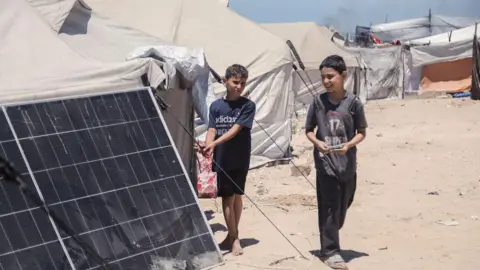 Getty Images
Getty ImagesA joint assessment from earlier this year by the World Bank, European Union and UN estimated that more than 80% of power generation and distribution assets have either been destroyed or are non-operational since the start of the war, at an estimated cost in damages of more than $494m.
Gaza Electricity Distribution Cooperation (Gedco), the company responsible for managing electricity supply across the Gaza Strip, say 70% of its buildings and facilities have been destroyed since October 2023.
At the end of last month, we verified video of the company’s headquarters being struck.
In a statement following the event, Gedco said the attack had “directly affected the company’s ability to manage its administrative and technical businesses”.
Agriculture
The satellite image below of one area east of Jabalia shows how 4 sq km of crops – likely olive and citrus trees – were wiped out over the course of the war.
Running through the razed ground is a road or track established by the IDF, probably to provide access to northern areas of nearby Gaza City.
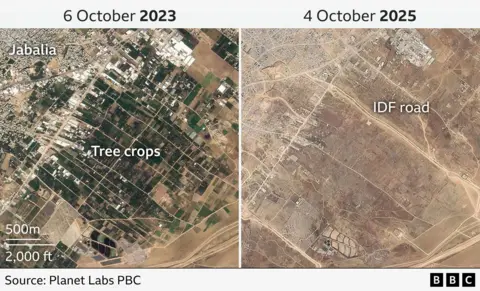
Analysis by Prof He Yin of Kent State University found that across the Gaza Strip, 82.4% of annual crops and more than 97% of tree crops were likely to have suffered damage during the war up to 10 August this year.
The decline of agriculture, coupled with prolonged restrictions on aid, drove severe food insecurity throughout the conflict, culminating in a famine declaration in Gaza City in September.
Unosat attributes this decline to the “impact of activities such as razing, heavy vehicle activity, bombing, shelling, and other conflict related dynamics”.
Mr Bouverat says that in order for agriculture to recover, the land needs to be cleared of unexploded bombs, shells and mines “pretty urgently”. “If they can grow their own crops, they can feed themselves, and the sooner we do that the better,” he says.
Education
About half of Gaza’s population before the war was aged under 18, so rebuilding schools is essential for any return to normal life.
School buildings became shelters for displaced Palestinians throughout the conflict, and were frequently targeted by IDF forces with the justification that they housed “command and control” centres for Hamas and affiliated groups.
The UN relief agency for Palestine, Unrwa, which once operated 288 schools in Gaza, says 91.8% of all of school buildings will require “full reconstruction or major rehabilitation work to be functional again”.
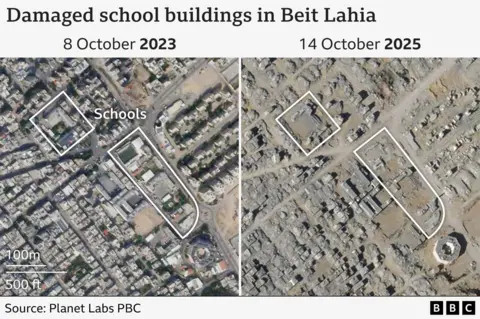
Higher education institutions have also not been spared.
For example, in December 2023, the al-Azhar University to the south of Gaza City was blown up by Israeli troops. The site is now part of the Netzarim Corridor, one of several miilitarised zones established by the IDF over the course of the war.
The same fate befell the Israa University less than 2km away. which was demolished by IDF troops after serving as a temporary base for several weeks.

